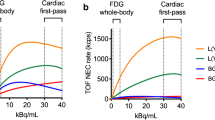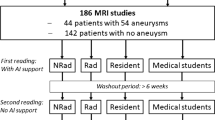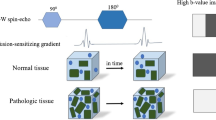Abstract
The aim of this study is to report the authors’ initial clinical experience of a 320-detector row computed tomography (CT) scanner in cerebrovascular disorders. Volumetric CT using the full 160-mm width of the 320 detector rows enables full brain coverage in a single rotation that allows for combined time-resolved whole-brain perfusion and four-dimensional CT angiography (CTA). The protocol for the combined dynamic CTA and CT perfusion (CTP) is presented, and its potential applications in stroke, stenoocclusive disease, arteriovenous malformations and dural shunts are reviewed based on clinical examples. The combined CTA/CTP data can provide visualization of dynamic flow and perfusion as well as motion of an entire volume at very short time intervals which is of importance in a variety of pathologies with altered cerebral hemodynamics. The broad coverage enabled by 320 detector rows offers z-axis coverage allowing for whole-brain perfusion and subtracted dynamic angiography of the entire intracranial circulation.
Zusammenfassung
Das Ziel der vorliegenden Studie ist es, die eigene klinische Erfahrung mit einem 320-Zeilen-Computertomographen (CT) bei zerebrovaskulären Erkrankungen zu präsentieren. Die Detektorbreite von 16 cm ermöglicht die Erfassung des gesamten Schädels mit nur einer Rotation, ohne dass eine Patienten- oder Gantrybewegung durchgeführt werden muss. Dies ermöglicht zeitaufgelöste CT-Angiographien (CTA) und CT-Perfusion (CTP). In dieser Arbeit wird ein CT-Protokoll präsentiert, mit dem nach nur einer Kontrastmittelapplikation sowohl CTA- als auch CTP-Daten rekonstruiert werden können. Anwendungen für dieses Protokoll sind der akute Schlaganfall, stenookklusive Erkrankungen sowie die prätherapeutische Abklärung und Verlaufskontrolle arteriovenöser Malformationen und Fisteln (sowohl in der Erstdiagnose wie auch bei Verlaufskontrollen). Im Rahmen von Patientenbeschreibungen werden einige der klinischen Applikationen dieses Protokolls vorgestellt. Die kombinierte Akquisition von CTA- und CTP-Daten kann nicht nur die Dynamik der Hirndurchblutung darstellen, sondern ist auch in der Lage, Bewegungen des untersuchten Volumens zu visualisieren. Durch Abbildung des gesamten Hirnvolumens in nur einer Rotation ergibt sich eine Vielzahl von klinischen Applikationen.
Similar content being viewed by others
References
Kalender WA, Seissler W, Klotz E, Vock P. Spiral volumetric CT with single-breath-hold technique, continuous transport, and continuous scanner rotation. Radiology 1990;176:181–3
Rankin SC. Spiral CT: vascular applications. Eur J Radiol 1998;28:18–29
Klingebiel R, Siebert E, Diekmann S, Wiener E, Masuhr F, Wagner M, Bauknecht HC, Dewey M, Bohner G. 4-D imaging in cerebrovascular disorders by using 320-slice CT: feasibility and preliminary clinical experience. Acad Radiol 2009;16:123–9
Siebert E, Bohner G, Dewey M, Masuhr F, Hoffmann KT, Mews J, Engelken F, Bauknecht HC, Diekmann S, Klingebiel R. 320-slice CT neuroimaging: initial clinical experience and image quality evaluation. Br J Radiol 2009;82:561–70
Kitagawa K, Lardo AC, Lima JA, George RT. Prospective ECG-gated 320 row detector computed tomography: implications for CT angiography and perfusion imaging. Int J Cardiovasc Imaging 2009:in press (Epub 2009 Feb 18)
Rybicki FJ, Melchionna S, Mitsouras D, Coskun AU, Whitmore AG, Steigner M, Nallamshetty L, Welt FG, Bernaschi M, Borkin M, Sircar J, Kaxiras E, Succi S, Stone PH, Feldman CL. Prediction of coronary artery plaque progression and potential rupture from 320-detector row prospectively ECG-gated single heart beat CT angiography: Lattice Boltzmann evaluation of endothelial shear stress. Int J Cardiovasc Imaging 2009:in press (Epub 2009 Jan 15)
Krings T, Willems PWA, Barfett J, Ellis M, Hinojosa N, Blobel J, Geibprasert S. Pulsatility of an intracavernous aneurysm demonstrated by dynamic 320-detector row CTA at high temporal resolution. Cent Eur Neurosurg 2009:in press
Brouwer PA, Bosman T, Van Walderveen MAA, Krings T, Leroux A, Willems PWA. Dynamic 320 slice CT angiography in cranial arteriovenous shunting lesions. AJNR Am J Neuroradiol 2009:in press
Bacigaluppi S, Dehdashti AR, Agid R, Krings T, Tymianski M, Mikulis DJ. The contribution of imaging in diagnosis, preoperative assessment, and follow-up of moyamoya disease: a review. Neurosurg Focus 2009; 26:E3
San Millan Ruiz D, Murphy K, Gailloud P. 320-multidetector row whole-head dynamic subtracted CT angiography and whole-brain CT perfusion before and after carotid artery stenting: technical note. Eur J Radiol 2009:in press (Epub 2009 Apr 30)
Chaves C, Hreib K, Allam G, Liberman RF, Lee G, Caplan LR. Patterns of cerebral perfusion in patients with asymptomatic internal carotid artery disease. Cerebrovasc Dis 2006;22:396–401
Cohnen M, Wittsack HJ, Assadi S, Muskalla K, Ringelstein A, Poll LW, Saleh A, Modder U. Radiation exposure of patients in comprehensive computed tomography of the head in acute stroke. AJNR Am J Neuroradiol 2006;27:1741–5
Srinivasan A, Goyal M, Lum C, Nguyen T, Miller W. Processing and interpretation times of CT angiogram and CT perfusion in stroke. Can J Neurol Sci 2005;32:483–6
Scharf J, Brockmann MA, Daffertshofer M, Diepers M, Neumaier-Probst E, Weiss C, Paschke T, Groden C. Improvement of sensitivity and interrater reliability to detect acute stroke by dynamic perfusion computed tomography and computed tomography angiography. J Comput Assist Tomogr 2006;30:105–10
Ezzeddine MA, Lev MH, McDonald CT, Rordorf G, Oliveira-Filho J, Aksoy FG, Farkas J, Segal AZ, Schwamm LH, Gonzalez RG, Koroshetz WJ. CT angiography with whole brain perfused blood volume imaging: added clinical value in the assessment of acute stroke. Stroke 2002;33:959–66
Lev MH, Nichols SJ. Computed tomographic angiography and computed tomographic perfusion imaging of hyperacute stroke. Top Magn Reson Imaging 2000;11:273–87
Cullen SP, Symons SP, Hunter G, Hamberg L, Koroshetz W, Gonzalez RG, Lev MH. Dynamic contrast-enhanced computed tomography of acute ischemic stroke: CTA and CTP. Semin Roentgenol 2002;37: 192–205
Murphy BD, Fox AJ, Lee DH, Sahlas DJ, Black SE, Hogan MJ, Coutts SB, Demchuk AM, Goyal M, Aviv RI, Symons S, Gulka IB, Beletsky V, Pelz D, Hachinski V, Chan R, Lee TY. Identification of penumbra and infarct in acute ischemic stroke using computed tomography perfusion- derived blood flow and blood volume measurements. Stroke 2006;37:1771–7
Geibprasert S, Pereira V, Krings T, Jiarakongmun P, Toulgoat F, Pongpech S, Lasjaunias P. Dural arteriovenous shunts: a new classification of craniospinal epidural venous anatomical bases and clinical correlations. Stroke 2008;39:2783–94
van Dijk JM, terBrugge KG, Willinsky RA, Wallace MC. Clinical course of cranial dural arteriovenous fistulas with long-term persistent cortical venous reflux. Stroke 2002;33:1233–6
Griffiths PD, Hoggard N, Warren DJ, Wilkinson ID, Anderson B, Romanowski CA. Brain arteriovenous malformations: assessment with dynamic MR digital subtraction angiography. AJNR Am J Neuroradiol 2000;21:1892–9
Warren DJ, Hoggard N, Walton L, Radatz MW, Kemeny AA, Forster DM, Wilkinson ID, Griffiths PD. Cerebral arteriovenous malformations: comparison of novel magnetic resonance angiographic techniques and conventional catheter angiography. Neurosurgery 2001;48:973–82, discussion 982–73
Fiehler J, Illies T, Piening M, Saring D, Forkert N, Regelsberger J, Grzyska U, Handels H, Byrne JV. Territorial and microvascular perfusion impairment in brain arteriovenous malformations. AJNR Am J Neuroradiol 2009;30:356–61
Reinacher P, Reinges MH, Simon VA, Hans FJ, Krings T. Dynamic 3-D contrast-enhanced angiography of cerebral tumours and vascular malformations. Eur Radiol 2007;17:Suppl 6:F52–62
Bendszus M, Koltzenburg M, Burger R, Warmuth-Metz M, Hofmann E, Solymosi L. Silent embolism in diagnostic cerebral angiography and neurointerventional procedures: a prospective study. Lancet 1999;354:1594–7
Heiserman JE, Dean BL, Hodak JA, Flom RA, Bird CR, Drayer BP, Fram EK. Neurologic complications of cerebral angiography. AJNR Am J Neuroradiol 1994;15:1401–7, discussion 1408–11
Kaufmann TJ, Huston J 3rd, Mandrekar JN, Schleck CD, Thielen KR, Kallmes DF. Complications of diagnostic cerebral angiography: evaluation of 19,826 consecutive patients. Radiology 2007;243:812–9
Dumoulin CL, Cline HE, Souza SP, Wagle WA, Walker MF. Three-dimensional time-of-flight magnetic resonance angiography using spin saturation. Magn Reson Med 1989;11:35–46
Ozsarlak O, Van Goethem JW, Maes M, Parizel PM. MR angiography of the intracranial vessels: technical aspects and clinical applications. Neuroradiology 2004;46:955–72
Krings T, Hans FJ, Moeller-Hartmann W, Thiex R, Brunn A, Scherer K, Stein KP, Meetz A, Allery E, Thron A. Time-of-flight-, phase contrast and contrast enhanced magnetic resonance angiography for pre-interventional determination of aneurysm size, configuration, and neck morphology in an aneurysm model in rabbits. Neurosci Lett 2002;326: 46–50
Prince MR. Contrast-enhanced MR angiography: theory and optimization. Magn Reson Imaging Clin N Am 1998;6:257–67
Hennig J, Scheffler K, Laubenberger J, Strecker R. Time-resolved projection angiography after bolus injection of contrast agent. Magn Reson Med 1997;37:341–5
Krings T, Hans F. New developments in MRA: time-resolved MRA. Neuroradiology 2004;46:Suppl 2:s214–22
Taschner CA, Gieseke J, Le Thuc V, Rachdi H, Reyns N, Gauvrit JY, Leclerc X. Intracranial arteriovenous malformation: time-resolved contrast- enhanced MR angiography with combination of parallel imaging, keyhole acquisition, and k-space sampling techniques at 1.5 T. Radiology 2008;246:871–9
Yamamoto S, Koyama Y, Suzuki M, Nagasawa H, Kakinuma R, Moriyama N. Optimized control of X-ray exposure and image noise using a particular multislice CT scanner. Nippon Hoshasen Gijutsu Gakkai Zasshi 2008;64:955–9
Hirata M, Sugawara Y, Fukutomi Y, Oomoto K, Murase K, Miki H, Mochizuki T. Measurement of radiation dose in CT perfusion study. Radiat Med 2005;23:97–103
Matsumoto M, Kodama N, Endo Y, Sakuma J, Suzuki KY, Sasaki T, Murakami K, Suzuki KE, Katakura T, Shishido F. Dynamic 3D-CT angiography. AJNR Am J Neuroradiol 2007;28:299–304
Author information
Authors and Affiliations
Corresponding author
Rights and permissions
About this article
Cite this article
Salomon, E.J., Barfett, J., Willems, P.W.A. et al. Dynamic CT Angiography and CT Perfusion Employing a 320-Detector Row CT. Clin Neuroradiol 19, 187–196 (2009). https://doi.org/10.1007/s00062-009-9019-7
Received:
Accepted:
Published:
Issue Date:
DOI: https://doi.org/10.1007/s00062-009-9019-7




